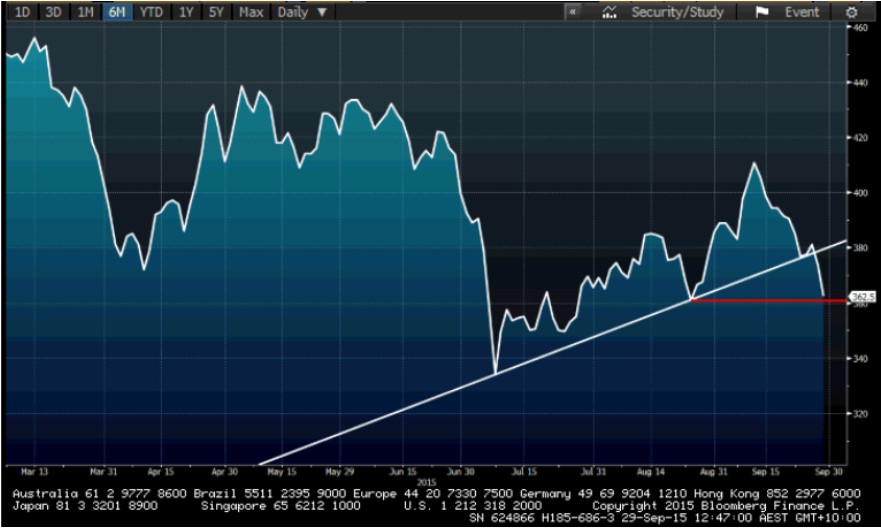Chris Weston, Chief Market Strategist at IG Markets
Traders and investors alike are being schooled on the importance of adjusting portfolios to the effects of volatility. Volatility is one of the four key variables that simply have to be considered if one is to survive and thrive in the capital markets – the others being understanding positioning, technicals (and price action), and sentiment.
Contrarians can operate against these variables, but that really depends on their style and timeframes. As things stand, and taking all the various factors into account, the time to be a contrarian is not upon us. If the GFC taught us anything, it’s that it’s best not to own assets when you don’t understand why they’re going down (especially aggressively). Capital preservation is taking place now before our eyes.
The credit markets have been screaming out this bearish message for some time, with the high yield ETF (HYG) at the lowest level since 2012. We can also look at the US fixed income yield curve, which has fallen sharply since July and is eyeing the January lows of 119 basis points (bp) with earnest. The fact the US 10-year treasury is back below the 200-day moving average is also key. In Australia, the yield curve has flattened some 27bp since April to 75bp. This tells me that investors have real concerns with longer-term inflation expectations, but there are many question markets around growth.
We have to wait until 2 December for Australian Q3 GDP, but it seems tough to believe the consensus of 0.7% quarterly growth is going to materialise, especially if real economic factors (such as consumer confidence) are affected by the underlying market trends and volatility.
One factor that has been cited is the effective withdrawal of liquidity from markets. Yesterday we heard Saudi Arabia had withdrawn $70b from outside fund holdings, adding to that of nations such as China who have been drawing down on its FX reserves. The liquidity withdrawal is easily trumping the QE injections from the ECB and BoJ and this is causing a tightening of global financial conditions. As well as this, it’s not often that one single corporation can influence other markets, but that’s what we are seeing with Glencore (GLEN). There is clearly a sustained and ferocious attack on its equity and it’s unclear whether this is a genuine view that the company is not going to be around in six months.
However, a simple look at some of the more liquid debt issuance shows fixed income investors see GLEN as a high yield play and not investment grade. The cost to protect against bond default (Credit Default Swaps or CDS) is skyrocketing and, in turn, this is hurting the equity – all leading to the perception we are going to see counterparty risk increase and forced selling from the GLEN trading desk. There is a growing feedback loop between GLEN and the broader commodity trade.
What else have we learnt today?
- Given what we have seen from GLEN and the idea that commodities could come under further pressure, watch price action in copper. Technically copper is oversold, but that is a reflection of the power behind the selling. The 24 August lows ($2.22p/lb) are firmly in sight, although the former May downtrend may come into play.
- The ASX 200 has convincingly broken through the bottom of the 5000-to-5200 range it has been trading in since late August. Equity traders will be watching for a move into the 25 August low of 4928, but I’d be more interested in whether the SPI futures can close through its own recent low of 4864.
- All sectors have been smashed today. In fact, 98% of companies are lower on the day, which is not something you often see in Australia. Include the Nikkei and Hang Seng, and there are six stocks higher on the day in these three key markets (out of 475). Miners have naturally been at the heart of the move and it seems traders are absolutely concerned about follow-through selling in the commodity complex overnight.
- Market volumes are fairly light given the size of the falls, with turnover 20% below the 30-day average at the time of writing.
- AUD/USD is eyeing a move into the 4 September lows of $0.6904, although some modest buying is creeping in, helped to a degree by some stability in iron ore futures. Keep in mind iron ore futures have broken the multi-month uptrend, with momentum accelerating to the downside.
(Daily chart of iron ore futures)

- Chinese markets are not reacting too aggressively to the volatility in global markets, but the same can’t be said for the Hang Seng or H-shares (down around 3.5% a piece).
- US futures have started rolling over, in fitting with the strong selling in Asia. Our European equity market calls are suggesting a progressively lower open, but of course that could still change and it’s hard to see anyone getting too excited given current sentiment. Data is on the light side and I don’t see any of the scheduled data causing too much in the way of short covering.
The key question we’ve been asking is: What is going to alter sentiment when there are so many factors and moving parts are at play? This is just so unclear, but it has to be a collective and coordinated move and, judging by recent central bank commentary, this is not coming anytime soon.
I suspect it would need to come from the big pension (buy-side) funds, who make a collective call that the pessimism has gone too far and that valuations are very compelling. It doesn’t seem like we are anywhere near to that point yet.
Ahead of the European open we are calling the FTSE at 5910 -48, DAX 9426 -57, CAC 4315 -42, IBEX 9314 -80 and MIB 20568 -191